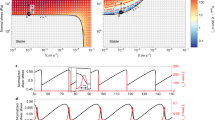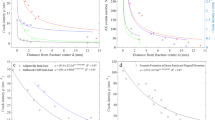Abstract
Experimentally based friction laws1,2 have been found to predict virtually the entire range of observed behaviour of natural faults3,4. These laws contain a critical slip distance, L, which plays a key role in determining the degree of fault instability, the size of the zone of earthquake nucleation, the frictional breakdown width, and the proportion of pre- and post-seismic slip to co-seismic slip. In laboratory measurements L is found to be about 10−5m, but modelling results show that it must be about 10−2m if natural earthquake behaviour is to be simulated. The discovery that fault surfaces are fractal over the scale range 10−5–105 (refs 5,6), even for faults with large net slip, has confused the problem of scaling this parameter from laboratory experiments to natural faults, because fractal surfaces have no characteristic length. Here I show that geometrically unmated fractal surfaces, when in contact under a normal load, develop a characteristic length in their contact because long-wavelength apertures close under load whereas short-wavelength apertures may remain open. This critical distance may be identified with L, and calculations based on fault topography data show that at seismogenic depths it will be in the range anticipated from the earthquake modelling studies.
This is a preview of subscription content, access via your institution
Access options
Subscribe to this journal
Receive 51 print issues and online access
$199.00 per year
only $3.90 per issue
Buy this article
- Purchase on Springer Link
- Instant access to full article PDF
Prices may be subject to local taxes which are calculated during checkout
Similar content being viewed by others
References
Dieterich, J. H. J. geophys. Res. 84, 2161–2168 (1979).
Ruina, A. L. J. geophys. Res. 88, 10359–10370 (1983).
Tse, S. T. & Rice, J. R. J. geophys. Res. 91, 9452–9472 (1986).
Stuart, W. D. PAGEOPH 126, 619–641 (1988).
Brown, S. R. & Scholz, C. H. J. geophys. Res. 90, 12575–12582 (1985).
Scholz, C. H. & Aviles, C. A. in Earthquake Source Mechanics (eds Das, S., Boatwright, J. & Scholz, C.) 147–155, (Am. Geophys. Un. Washington, DC, 1986).
Rabinowicz, E. J. appl. Phys. 22, 1373–1379 (1951); J. appl. Phys. 27, 131–135 (1956); Proc. phys. Soc. Lond. 71, 668–675 (1958).
Okubo, P. G. & Dieterich, J. H. J. geophys. Res. 89, 5817–5827 (1984).
Walsh, J. B. J. geophys. Res. 70, 381–389 (1965).
Brown, S. R. & Scholz, C. H. J. geophys. Res. 90, 5531–5545 (1985).
Mandelbrot, B. B. The Fractal Geometry of Nature 236 (Freeman, San Francisco, 1983).
Power, W. L., Tullis, T. E. & Weeks, J. D. J. geophys. Res. 93 (in the press).
Marone, C. & Scholz, C. H. Geophys. Res. Lett. 15, 621–624 (1988).
Dieterich, J. H. in Earthquarke Source Mechanics (eds Das, S., Boatwright, J. & Scholz, C.) 37–47 (Am. Geophys. Un. Washington, DC, 1986).
Das, S. & Scholz, C. H. Nature 305, 621–623 (1983).
Author information
Authors and Affiliations
Rights and permissions
About this article
Cite this article
Scholz, C. The critical slip distance for seismic faulting. Nature 336, 761–763 (1988). https://doi.org/10.1038/336761a0
Received:
Accepted:
Issue Date:
DOI: https://doi.org/10.1038/336761a0
This article is cited by
-
Gravity-induced seismicity modulation on planetary bodies and their natural satellites
Scientific Reports (2024)
-
Dueling dynamics of low-angle normal fault rupture with splay faulting and off-fault damage
Nature Communications (2023)
-
Non-monotonic Dynamics in the Onset of Frictional Slip
Tribology Letters (2022)
-
Geodetic analysis of the tectonic crustal deformation pattern in the North Aegean Sea, Greece
Mediterranean Geoscience Reviews (2021)
-
Causal mechanism of injection-induced earthquakes through the Mw 5.5 Pohang earthquake case study
Nature Communications (2020)
Comments
By submitting a comment you agree to abide by our Terms and Community Guidelines. If you find something abusive or that does not comply with our terms or guidelines please flag it as inappropriate.



